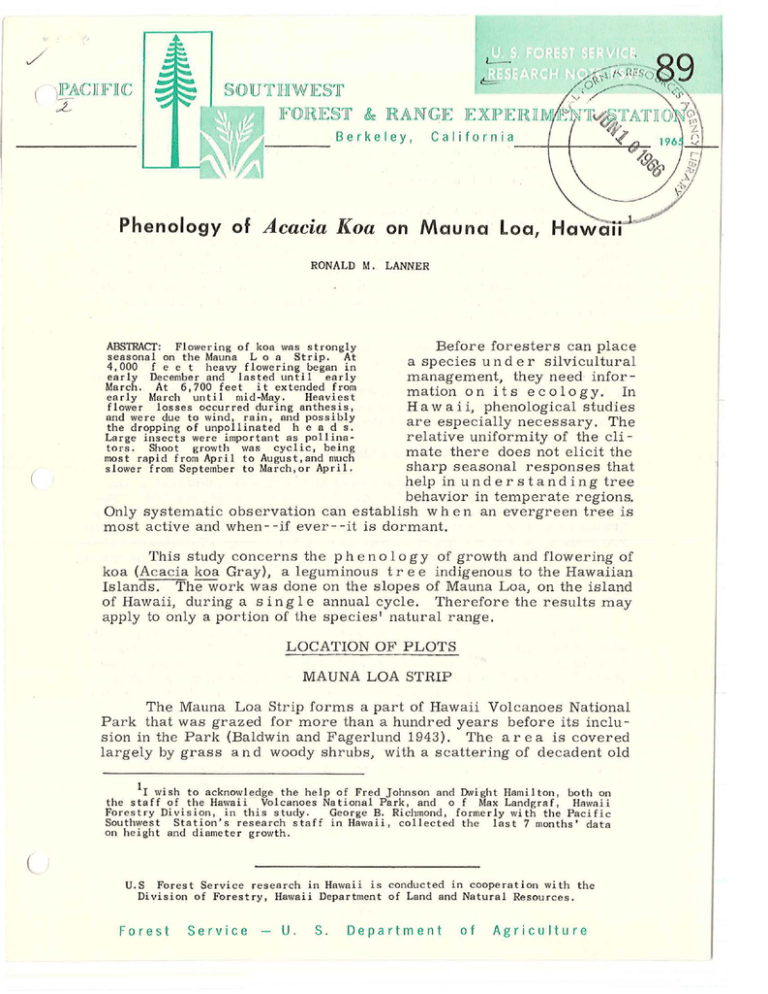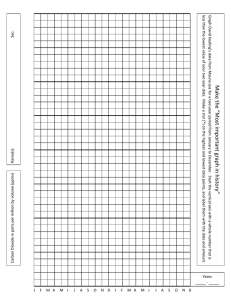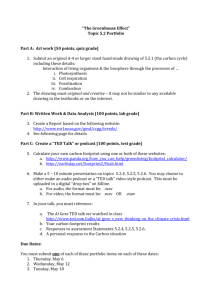:L Acac a K a
advertisement

( lPACTIJFll(C :L §OlUTJHIWJE§'f JFORJE§'f & RANGJE JEXlPJERll Phe nolog y of Acacia K oa on M auna Loa , Haw a u · RONALD M. LANNER ( Before foresters can plac e a species under silvicu ltural management, they need information on its ecology. In H a waii, ph enological studies are e specially necessary. The relative uniformity of the elimate ther e does not e li c it the sharp seasonal responses that h elp in u n d e r stand in g tree behavior in temperate regions. Only systematic observation can establish when an evergreen tree is most active and when - -if ever- - it is dorma nt . ABSTRACf: Flowering of koa was strongly seasonal on the Mauna L o a Strip. At 4,000 f e e t heavy flowering began in early December and lasted until early March. At 6,700 feet it extended from early March until mid-May. Heaviest flower losses occurred during an thesis, and were due to wind, rain, and possibly the dropping of unpollinated h e a d s. Large insects were important as pollina tors. Shoot growth was cyclic, being most rapid from Apri l to August,and much slower from September to March,or April. This study concerns th e phenology of growth and flow ering of koa (Acacia koa Gray), a leguminous tree indigenous to the Hawaiian Isla nds . The work was done on the slopes of Mauna Loa, on the island of Hawaii, during a single annual cycle . Therefore the results may apply to only a portion of the species' natural range. LOCATION OF PLOTS MAUNA LOA STRIP T he Mauna Loa Strip forms a part of Hawaii Vol cano es National Park that was grazed for more than a hundr ed years before its inclusion in the Park (Baldwin and Fagerlund 1943 ). The area is covered largely by grass and woody shrubs, with a scattering of d ecadent old 1 r wish to acknowledge the help of Fred Johnson and Dwight Hamilton, bo th on the s taff of the Hawaii Vol ca noes National Park, and o f Max Landgraf, Hawa ii Fores try Divi s ion, in thi s study. George B. Ri chmond , forme rly with the Pacific Southwest Station's r esea rch staff in Hawa ii , collected the las t 7 months' data on h e ight and diameter growth . U. S Forest Se rvi ce resea rch in Hawaii i s conducted in cooperation with the Division of Forestry, Hawaii Depa rtment of Land and Natur a l Resour ces. For e s t Se rvic e - U. S. De p a rtm e nt of A g ri c u l tur e koa trees. Many of the old trees are nuclei of clones resulting from prolific root-suckering that is gradually increasing the area dominated by koa. Some clones have merged, forming patches of woodland several acres in extent; others occupy relatively little area and are surrounded by grass and brushland. The seven plots on the Mauna Loa Strip lay on a transect extending from 3, 900 to 6, 700 feet on the southeast face of Mauna Loa, a domeshaped active volcano more than 13, 000 feet high. Within this transect rainfall is fairly uniform, but absolute rainfall values may fluctuate greatly from year to year and from month to month. Winter is the rainy season and the summer months--especially June--are usually quite dry. Median annual rainfall is 7 5 inches at 4, 000 feet and 58. 1 inches at 6, 700 feet (Taliaferro 1959). Temperatures vary only slightly from month to month, or from year to year. They drop as elevation increases, following much the same pattern as that on the volcano Haleakala on the neighboring island of Maui (Britten 1962). Above 5, 000 feet frost develops in the wintertime. At higher elevations the temperature range widens, minimum temperatures drop, and rainfall decreases. WAIAKEA FOREST RESERVE Two other plots were established at 1, 750 and 3, 600 feet in the Waiakea Forest Reserve, on the east -facing slope of Mauna Loa. The Reserve is more directly exposed to the northeast trade winds than the Mauna Loa Strip. At the lower elevation median annual rainfall exceeds 200 inches, and at the upper elevation it is 150 inches (Taliaferro 1959). Seasonal distribution of rainfall is much more uniform than on the Mauna Loa Strip. FLOWERING AND SEEDING Flowering is difficult to observe in the rain forest, and seed pods are not readily visible until they approach maturity. But on the Mauna Loa Strip many old trees grew up while the area was in pasture. And many flowering branches can be reached from the ground. For this reason, we limited the studies of flowering to the Mauna Loa Strip plots. The koa inflorescence is a raceme of up to 10 or more globose heads, each consisting of about 50 closely packed flowers. When the flowers open, the head is about 1 I 2 inch in diameter and pale yellow. After fertilization the flowers wither. One or two (rarely up to five) downy yellow seed pods begin to grow from the head. Seeds may be released from the mature pod by splitting of the pod along its sutures, or by a pod falling to the ground with its seeds still inside. -2- METHODS Three of the Mauna Loa Strip plots (Nos. 2, 4, 7) were used for detailed study of flower and pod development. A plot consisted of one to three trees. Monthly counts were started in September 1963 on 16 tagged branches with 356 flower heads. During anthesis, weekly observations were made. The 11 branches in plots 2 and 4 were diagramed individually to record gains and losses of flower heads by raceme as the season progressed. To document the development of the flowers, a numerical system of classification was devised (fig. 1). This system made it easier to describe the flowering stage; with practice it can be used to predict approximate date of anthesis. Other observations were made elsewhere along the transect. Thus, a major flush of flowering was observed as it proceeded up the slope from 3, 900 to 6, 700 feet. RESULTS TIME OF FLOWERING In September 1963, a potentially heavy flower crop was observed on the Mauna Loa Strip. The flowers were then in stages 2 and 3, except above 5, 700 feet, where they were only in stage 1. This developing flower crop was the subject of this study. In addition to the oncoming crop, it was almost always possible to find occasional open flowers on the lower part of the transect. But the magnitude of the major flush far overshadowed the trickle of flowering during the rest of the year. The major flush moved upslope at about 300 feet of elevation per week. Anthes is started at 4, 000 feet in early December. It reached 6, 700 feet by the first week of March, when flowering had practically ceased at 4, 000 feet. But at 6, 700 feet heavy flushing continued until mid-May (fig. 2). FLOWER AND SEED POD LOSSES The monthly flower-head counts permitted estimates of head and pod losses throughout the flowering cycle. The most detailed data were from plots 2 and 4. Before the flowers opened, the number of flower heads gradually dwindled (fig. 3). Apparently this drop was caused by Lycaena blackburni Tuely caterpillars2 feeding on immature flower heads. ~ Much~ heavier losses occurred after the flowers had opened, probably because of wind, rain, and the dropping of unpollinated heads (fig. 3). Fruit-set was very low: of the 332 heads in plots 2 and 4, 223 reached maturity but only 34 seed pods started to develop (table 1). ---- 2 Er~est.Yoshioka, ·Hawaii Dep, Agr., Hilo. -3- Figure 1.--Flavering stages in Acacia koa, shO\m .twice natural size. . ' Mature pads 4 2 6 8 7aoo o Occasional or scattered flowers 0 • Heavy flush 0 ~6000 ~ • • • • 00 - ~ ·~ "• iii" 5000 • p- 0 0 0 0 00 4POO 0 -, ,o 0 Jun Jul. Aug. ,o Sep. Oct. Nov. ...,. Figure 2.--0ccurrence of open flowers }Stage 8) the Mauna Loa Strip transect, 1963- 964. on • Dec. • •• • • 0 0 0 0 0 0 0 0 0 0 0 0 0 •,• 0 Feb. Jan. • • • 0 0 ooe ••• 0 •• ••• ••• 0 • 0 • ••• 0 I 0 0 0 • •• •• 0 Mar. 0 0 ' Apr. p 0 0 May Jun. 400 300 Figure 3.--The number of flower heads and seed pods dropped throughout flowering cycle. The flower development stage shown was the one prevailing during first week of the month. 100 0 Nov. Dec. Jon. Feb. Mar. Apr. May 2 -4- 2 3 4 8 Pods ...... . Flower development stage Despite the low level of fruit-set, the pod crop in plots 2 and 4 was an impressive sight. But by early March nearly every pod was afflicted by damage of unknown origin that resulted in necrosis, curling, and eventual death. The few pods that escaped this fate were invaded by koa seed moth (Cryptophlebia illepida Butler). Further losses were due to dropping of seed pods less than 1 inch long. This may have been the result of selfing, as in some Acacias in South Africa (Anonymous 1960). Table 1. --Prodt1ction of flower heads, seed pods, and seeds on study branches of koa on three plots of the Mauna Loa Strip, Island of Hawaii, 1963-64 Plot and Branch elevation No. No. 2 42 43 44 45 46 47 -- - - - OPEN FOLLINA1ED Flower heads ~-------------r--Seed pods Seeds ~ri ~~lall~~~_!l!_~·~_? -~n-i tia te_~] M~!~:_ued !r~d-u~c:_~IVi!~-le Nwnber ~4,020 eet) 0 15 1 26 24 27 29 27 59 41 0 0 0 4 13 13 so 40 0 0 0 0 0 0 0 0 0 0 0 0 0 0 0 0 0 0 30 0 0 0 2 0 0 0 0 0 0 6 0 6 0 0 0 6 0 6 0 0 0 5 0 5 ---~---------- Total No. 4 ~4,420 eet) 51 52 53 54 56 Total No. 7 ~4,960 / eet) 57 58 59 60 61 Total All -- plots 207 132 36 38 14 19 18 125 30 30 7 9 15 91 5 3 8 3 5 '--:----24 356 1 0 1 0 4 0 1 4 1 0 1 -- 0 0 0 7 0 0 0 1 1 2 1 0 0 0 10 0 -------10 230 36 2 16 11 2 0 0 2 0 0 0 0 0 0 0 0 0 0 0 0 0 0 0 0 0 0 0 0 0 0 0 0 0 0 0 1 1 -~>------------------- 1 0 MESH BAGS No. 2 ~ 4, 020 eet) Total 81 82 83 84 85 86 87 88 22 45 97 51 56 58 78 157 __ .___ 564 ____ , 1 9 0 1 15 POLLINATION AND FERTILIZATION In mid- December 196 3 a simple experiment was performed to determine whether the exclusion of large insects adversely affect fruitset. Eight bags made of 1 I 16 -inch fiberglass mesh screening were placed on branches bearing flower heads in stages 3 and 4, in plot 2. -5- The bags enclosed 564 heads that reached maturity. Only 15 seed pods were set. Thus, the level of fruit-set was 2. 7 percent. The 223 heads that reached maturity on open -pollinated branches in plots 2 and 4 produced 34 seed pods, a level of fruit-set exceeding 15 percent. These results suggest that insect pollination is necessary for a better than minimal level of fruit-set. They are consistent with the results of somewhat similar work with Acacia m South Africa (Anonymous 1959). Honeybees and other winged msects were often seen visiting the flowers during clear weather. POD AND SEED RIPENING Because of the nearly total loss of the seed crop, only one pod (in plot 7) yielded usable data. It reached full length within 10 weeks of flowering, but did not ripen until almost 7 months later. The Acacias vary in their seed maturation time. Philp and Sherry (1946) reported that green wattle (A. decurrens Willd.) matured its seeds 4 months after flowering, and black wattle (A. mollissima Willd.) required 13 months. The 7-month period reported-in this note is of course only indicative and requires substantiation. SHOOT GROWTH METHODS Shoot growth was studied on the Mauna Loa Strip (plots 5, 6, 7) by inserting a pin into the woody tissue of the leading shoot and measuring to the tip at monthly intervals. Six shoots were measured in each of three plots. These were root-suckers- -no seedlings of the required size could be found--and varied from 1 to 4 feet in height. Baldwin and Fagerlund (1943) also had noted the unexplained absence of seedling regeneration on the Mauna Loa Strip. Several root suckers were abandoned because insects or disease had killed the apex. On the Waiakea Forest Reserve, the total height of six young saplings was measured monthly throughout the year. Averaging 2 feet tall, these trees had germinated on ground that was cleared 7 months before the first measurement. RESULTS,,,.. On the Mauna Loa Strip, growth curves were cyclic. Shoots generally were dormant or very slow growing from September until about March or April, and a growth flush occurred from April until August. Though each plot sampled a single clone, there was much variation within each plot. Th·us individual tree curves have been shown, rather than plot averages which would mask this variation (fig. 4). As the shoots in each plot are genetically identical, variations in growth pattern must be due to microenvironmental or physiological differences. For example, shoot 14 in plot 5 (fig. 4) may owe its unusual winter growth surge to the stimulating effect of the rust Uromyces koae Arthur, to the attack of which it later succumbed.3 3 Personal communication from R. Raabe 1 University of Hawaii, Hila, 1963. -6- 400 300 Plot 5 200 100 700 600 Plot 6 500 ~ 400 ~ ~ 300 :£: e" "" 200 ~ "' 900 ~ 800 22 24 100 ~ " Plot 7 700 31 600 500 400 300 200 100 Jun. Jul. Nov. Dec. Jon. Feb. Mor Ape May Jun. Jul. Aug. Sep. 1963 1964 Figure 4. ~-Height growth of root sprouts of same clone on Mauna Loa Strip,1963-64. Phenology of a root sprout may also be influenced by its position on the root system of the clone parent tree. Despite the variations and exceptions, there is ample evidence height growth depends on the season on the Mauna Loa Strip. Vigorous tip-flushing--first seen at 4, 000 feet in March, shortly after flowering- -reached 6, 700 feet by the first of June. In contrast to these results are the growth curves from the Waiakea Forest Reserve (fig. 5). In this warmer and rainier area,no clear indication of a seasonal response was found. -7- 8 69 ., 6 ~ ~ "' .<;e> ~ l: 4 2 o~~~~~~~~~~~~~--~~~-L77~~~-J Sep. Oct. Nov. Dec. Jon. Feb. Mor. Apr. Moy Jun. Jul. Aug. Sep. 1963 1964 Fi~ure 5. ~~Height growth of koa saplings,1963~64, at the Wa1akea Forest Reserve (1,700 feet elevation). 300r-.--.--.--,-,--,--,--,-,--,--,--,--,-, MLS No.1\ 0~~~~~~~~~~~~~~~ Aug. Sep. Oct. Nov. Dec. Jan. Feb. Mar. Apr. May Jun. Jul. Aug. Sep. 1963 1964 Figure 6.~-Seasonal course of circumferential growth on the Mauna Loa Strip plots and on the Stainback plot in the Waia~ kea Forest Reserve, 1963-1964. -8- CIRCUMFERENTIAL GROWTH METHODS Monthly increases in circumference were measured by expandable tree-bands made from 1/2 -inch wide aluminum or copper alloy. These were adapted from the bands described by Liming (1957), In each of the Mauna Loa Strip plots (No. 1 at 3, 920 feet; No. 3 at 4, 200 feet; and No. 7 at 4, 960 feet), and a plot at 3, 600 feet in the Waiakea Forest Reserve, four trees were fitted with bands. The trees in plot 7 were root suckers of the same clone; the other trees are believed to be of seedling origin. Plot 3 was located in a kipuka4 under mesic conditions like those of a closed forest; the other trees were relatively open -grown. RESULTS During 13 months the fastest growing tree (in plot 1) grew 118 mm. and the slowest growing tree (in plot 3) grew only 4 mm. in circumference. Such differences were closely associated with size and freedom of the crown. Examination of the growth curves of the four plots fails to disclose evidence of a strong seasonal effect on cambial activity (fig. 6), From the silvicultural viewpoint diameter growth of koa on these sites can be regarded as a yearlong activity. In this respect koa more closely resembles typical evergreens of the wet tropics, where diameter growth proceeds as long as leaf activity persists (Richards 1957), than deciduous hardwoods of temperate areas, where diameter growth is strongly sigmoid (Kramer and Kozlowski 1960), LITERATURE CITED Anonymous. 1959. Pollination mechanism. In, Wattle Res. Inst. Rep. for 19581959. Univ. Natal, Pietermaritzburg: 22-23. Anonymous. 1960. Pollination mechanism. In, Wattle Res. Inst. Rep. for 19591960. Univ. Natal, Pietermaritzburg: 25. Baldwin, P. H., and Fager lund, G. 0. 1943. The effect of cattle grazing on koa reproduction in Hawaii National Park. Ecol. 24(1): 118-122, illus. Britten, E. J. 1962. Hawaii as a natural laboratory for research on climate and plant response. Pacific Sci. 16(2): 160-169, illus. ( Kramer, P. J., and Kozlowski, T. T. 1960. Physiology of trees. 642 pp., ill us. Hill Book Co. New York: McGraw- 4 An island of older soil and vegetation that escaped inundation by a surrounding lava flow. -9- Liming, F. G. 1957. Homemade dendrometers. ill us. J. Forestry 55(8): 575-577, Philp, J., and Sherry, S. P. The degree of natural crossing in green wattle, Acacia 1946. decurrens Willd., and its bearing on wattle breeding. J. S. African Forestry Ass. 14: 1-28, Richards, P. W. 1957. The tropical rain forest: an ecological study. illus. Cambridge: Cambridge Univ. Press. Taliaferro, W J. 1959. Rainfall of the Hawaiian Islands. Hawaii Water Authority. 450 pp., 394 pp., illus. Honolulu: nre Author--RQ~D M. LANNER·,was formerly on the Pacific Southwest Station's silvicultural research staff in Hilo, Hawaii. He is now at the School of Forestry, University of Minnesota St. Paul, Minnesota. ' -10-






